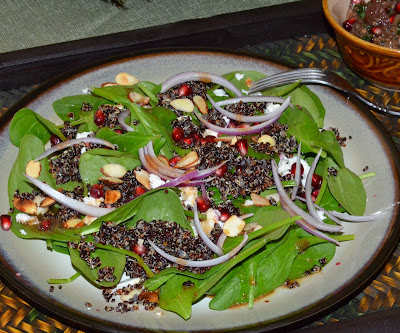 |
| Sabudana vada with coconut-sesame dipping sauce |
Lately, I have been so busy cooking that I haven't had time to post! This ridiculous flurry of activity started several weeks ago when I decided I wanted Ethiopian food. I spent a weekend making a batch of niter kibbeh and another of berbere. That same weekend I also made a huge jar of ginger/garlic paste, a jar of coconut chutney, and a wet spice blend for making green curry.
The next week, I found myself up to my eyebrows in Indian adventures. I made a batch of paneer and a batch of milk solids. I roasted and mixed up a variety of spice blends, including Madras curry powder, sambhar masala and a Punjabi garam masala.
Some things turned out quite undesirable, like the injera I made to go with my Ethiopian wats. Ugh! Not sure where I went wrong with such a simple recipe, but something was very not right! But other things turned out amazingly good, like the tapioca, potato, and peanut fritters with coconut-sesame dipping sauce.
I more or less followed Ragahavan Iyer's recipe in his wonderful book,
660 Curries
. Here's what he says to do, with just a few changes:
Ingredients:
3/4 cup pearl tapioca (rinsed, soaked for 20 minutes, drained)
1 cup dry-roasted peanuts
1/2 cup tightly packed cilantro
10 (or more!) hot chilies (such as Thai or cayenne)
6 large cloves garlic
2 thick slices fresh ginger (1/2 inch)
1 pound russet potatoes, boiled and coarsely mashed (I mashed mine by squishing them through my fingers!)
1 - 2 teaspoons kosher salt (depending on whether or not your peanuts are already salted)
Canola oil for frying
Method:
1. Grind peanuts in food processor by pulsing until coarsely chopped. Dump in large mixing bowl.
2. Combine cilantro, chilies, garlic, and ginger in processor and mince. Add to peanuts.
3. Add drained tapioca and mashed potatoes to mixing bowl and mix well. This will look and feel doughy. You can knead it like you would bread until the ingredients are well blended.
4. Grease or wet your palms and pull off about 2 T dough. Roll into a ball and then flatten into a disc. Continue until all the dough is used up.
5. Heat about 1 1/2 inches of oil over medium-high heat and fry fritters until golden and crispy on both sides.
6. Drain on paper towels.
Ingredients for the sauce:
1 T Canola oil
1/4 c shredded, unsweetened flaked coconut
1 T white sesame seeds
1/2 c dry-roasted peanuts
2 T chopped cilantro
1 t kosher salt
1 medium tomato, cored and coarsely chopped
4 hot green chilies (more or less to taste)
Method:
1. Heat the oil over medium-high heat. Add coconut and sesame seeds and fry, stirring frequently, until fragrant and golden.
2. Transfer to a blender and add 1 c water plus all the remaining ingredients. Puree until smooth and blended, scraping down sides of blender when necessary.
3. Transfer sauce to a small pot and bring to a boil. Lower heat and simmer gently for a minute or so.
To serve, you can place a couple of fritters on a plate and spoon some sauce over. Or you can place the sauce in a small bowl and dip the fritters. The sauce is got warm or at room temperature.
 |
| Chilies, cilantro, garlic, and ginger |
 |
| Minced herb and spices |
 |
| Tapioca, peanut and herb mince, mashed potatoes |
 |
| The dough |
 |
| The patties before frying |
 |
| Fritters with dipping sauce |






















